Virus entry via the alternative coreceptors CCR3 and FPRL1 differs by human immunodeficiency virus type 1 subtype
- PMID: 19553323
- PMCID: PMC2738165
- DOI: 10.1128/JVI.00780-09
Virus entry via the alternative coreceptors CCR3 and FPRL1 differs by human immunodeficiency virus type 1 subtype
Abstract
Human immunodeficiency virus type 1 (HIV-1) infects target cells by binding to CD4 and a chemokine receptor, most commonly CCR5. CXCR4 is a frequent alternative coreceptor (CoR) in subtype B and D HIV-1 infection, but the importance of many other alternative CoRs remains elusive. We have analyzed HIV-1 envelope (Env) proteins from 66 individuals infected with the major subtypes of HIV-1 to determine if virus entry into highly permissive NP-2 cell lines expressing most known alternative CoRs differed by HIV-1 subtype. We also performed linear regression analysis to determine if virus entry via the major CoR CCR5 correlated with use of any alternative CoR and if this correlation differed by subtype. Virus pseudotyped with subtype B Env showed robust entry via CCR3 that was highly correlated with CCR5 entry efficiency. By contrast, viruses pseudotyped with subtype A and C Env proteins were able to use the recently described alternative CoR FPRL1 more efficiently than CCR3, and use of FPRL1 was correlated with CCR5 entry. Subtype D Env was unable to use either CCR3 or FPRL1 efficiently, a unique pattern of alternative CoR use. These results suggest that each subtype of circulating HIV-1 may be subject to somewhat different selective pressures for Env-mediated entry into target cells and suggest that CCR3 may be used as a surrogate CoR by subtype B while FPRL1 may be used as a surrogate CoR by subtypes A and C. These data may provide insight into development of resistance to CCR5-targeted entry inhibitors and alternative entry pathways for each HIV-1 subtype.
Figures
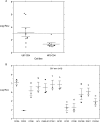
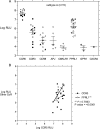
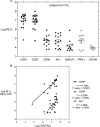
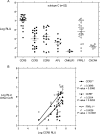
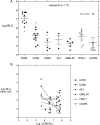

Similar articles
-
Linkages between HIV-1 specificity for CCR5 or CXCR4 and in vitro usage of alternative coreceptors during progressive HIV-1 subtype C infection.Retrovirology. 2013 Sep 16;10:98. doi: 10.1186/1742-4690-10-98. Retrovirology. 2013. PMID: 24041034 Free PMC article.
-
A formylpeptide receptor, FPRL1, acts as an efficient coreceptor for primary isolates of human immunodeficiency virus.Retrovirology. 2008 Jun 25;5:52. doi: 10.1186/1742-4690-5-52. Retrovirology. 2008. PMID: 18577234 Free PMC article.
-
CD4 receptor-dependent entry of human immunodeficiency virus type-1 env-pseudotypes into CCR5-, CCR3-, and CXCR4-expressing human alveolar macrophages is preferentially mediated by the CCR5 coreceptor.Am J Respir Cell Mol Biol. 1999 May;20(5):864-71. doi: 10.1165/ajrcmb.20.5.3547. Am J Respir Cell Mol Biol. 1999. PMID: 10226056
-
Effect of HIV-1 subtype and tropism on treatment with chemokine coreceptor entry inhibitors; overview of viral entry inhibition.Crit Rev Microbiol. 2015;41(4):473-87. doi: 10.3109/1040841X.2013.867829. Epub 2014 Mar 17. Crit Rev Microbiol. 2015. PMID: 24635642 Review.
-
A new insight into the role of "old" chemotactic peptide receptors FPR and FPRL1: down-regulation of chemokine receptors CCR5 and CXCR4.Forum (Genova). 1999 Oct-Dec;9(4):299-314. Forum (Genova). 1999. PMID: 10611407 Review.
Cited by
-
In vitro replicative fitness of early Transmitted founder HIV-1 variants and sensitivity to Interferon alpha.Sci Rep. 2020 Feb 17;10(1):2747. doi: 10.1038/s41598-020-59596-x. Sci Rep. 2020. PMID: 32066770 Free PMC article.
-
Transmission of Multiple HIV-1 Subtype C Transmitted/founder Viruses into the Same Recipients Was not Determined by Modest Phenotypic Differences.Sci Rep. 2016 Dec 2;6:38130. doi: 10.1038/srep38130. Sci Rep. 2016. PMID: 27909304 Free PMC article.
-
Viremic control and viral coreceptor usage in two HIV-1-infected persons homozygous for CCR5 Δ32.AIDS. 2015 May 15;29(8):867-76. doi: 10.1097/QAD.0000000000000629. AIDS. 2015. PMID: 25730507 Free PMC article.
-
Molecular identification, cloning and characterization of transmitted/founder HIV-1 subtype A, D and A/D infectious molecular clones.Virology. 2013 Feb 5;436(1):33-48. doi: 10.1016/j.virol.2012.10.009. Epub 2012 Nov 1. Virology. 2013. PMID: 23123038 Free PMC article.
-
The impact of genetic adaptation on chimpanzee subspecies differentiation.PLoS Genet. 2019 Nov 25;15(11):e1008485. doi: 10.1371/journal.pgen.1008485. eCollection 2019 Nov. PLoS Genet. 2019. PMID: 31765391 Free PMC article.
References
-
- Aasa-Chapman, M. M., K. Aubin, I. Williams, and A. McKnight. 2006. Primary CCR5 only using HIV-1 isolates does not accurately represent the in vivo replicating quasi-species. Virology 351489-496. - PubMed
-
- Alkhatib, G., E. A. Berger, P. M. Murphy, and J. E. Pease. 1997. Determinants of HIV-1 coreceptor function on CC chemokine receptor 3. Importance of both extracellular and transmembrane/cytoplasmic regions. J. Biol. Chem. 27220420-20426. - PubMed
Publication types
MeSH terms
Substances
Associated data
- Actions
Grants and funding
LinkOut - more resources
Full Text Sources
Medical
Molecular Biology Databases
Research Materials
Miscellaneous

